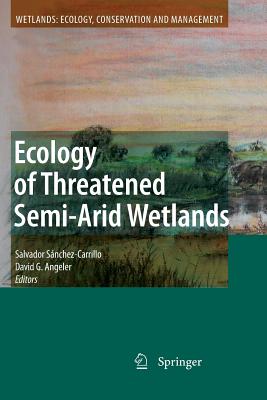You are here
Back to topEcology of Threatened Semi-Arid Wetlands: Long-Term Research in Las Tablas de Daimiel (Wetlands: Ecology #2) (Paperback)
Description
Part I Introductory Chapter
1 The Wetland, Its Catchment Settings and Socioeconomic Relevance: An Overview
S. S nchez-Carrillo, D.G. Angeler, S. Cirujano, and M. lvarez-Cobelas
1.1 Introduction
1.2 The Wetland: Las Tablas de Daimiel National Park
1.3 The Upper Guadiana Basin and the UNESCO's La Mancha H meda Biosphere Reserve
1.4 Groundwater Overexploitation and the Wetland Complex
1.5 Socioeconomic Aspects in the Upper Guadiana Basin
1.6 A Chronological Summary of TDNP Impacts and Its Degradation
References
Part II Abiotic Environment and Historical Reconstructions
2 Paleoenvironmental Reconstruction of Las Tablas de Daimiel and Its Evolution During the Quaternary Period
B. Ruiz-Zapata, M.J. Gil-Garc a, and I. de Bustamante
2.1 Introduction
2.2 Material and Methods
2.3 Overview of Vegetation Composition in La Mancha Region During Quaternary Period: Palaeo-Sequences Description
2.3.1 Landscape Evolution from 325,000 to 21,000 Years BP: LT, TD, TASG-1 and FUENT-1 Profiles
2.3.2 Landscape Evolution from 11,000 to 4,000 Years BP: MO and CC-17 Sequences
2.3.3 Landscape Evolution from 4,000 Years BP to the Present: CC-17 and Gig ela 4.2 Paleo-records
2.4 Summary of Climatic and Wetland Environmental Evolution During the Quaternary Period
2.4.1 Middle Pleistocene
2.4.2 Upper Pleistocene
2.4.3 Holocene
References
3 Climate and Hydrologic Trends: Climate Change Versus Hydrologic Overexploitation as Determinants of the Fluctuating Wetland Hydrology
S. S nchez-Carrillo and M. lvarez-Cobelas
3.1 Introduction
3.2 Material and Methods
3.3 Long-Term Climate Trends
3.4 An Historical Analysis of Wetland Hydroperiod and Inundation Patterns: The Importance of Groundwater
3.5 Long-Term Changes in the Wetland Water Budget: Hydrologic Degradation
3.6 Causes of Wetland Hydrologic Degradation: Climate Change Versus Hydrologic Overexploitation
3.7 Evapotranspiration Controls of Wetland Hydrology: A Conceptual Model
3.8 A Wetland Hydrological Model for Hydroperiod Restoration
3.9 Future Scenarios of TDNP Hydrology
References
4 The Effects of Anthropogenic Stressors on Wetland Loss and Habitat Quality Deterioration in the Upper Guadiana River Basin: A Long-Term Assessment (1970-2000)
R. S nchez-Andr's, M.O. Viedma, and S. S nchez-Carrillo
4.1 Introduction
4.2 Material and Methods
4.3 Wetland Cover and Extent of Hydrodynamic Types in the Early 1970s
4.4 Land Use-Land Cover Changes and Socioeconomic Indicators During 1978-2000
4.5 Wetland Losses from 1970 to 2000
4.6 Wetland Habitat Quality Evolution During the Period 1978-2000
4.7 Patterns on Wetland Loss and Habitat Quality Deterioration: the Infl uence of the Main Anthropogenic
Stressors at Local and Regional Scales
References
5 A Story of the Wetland Water Quality Deterioration: Salinization, Pollution, Eutrophication and Siltation
M. lvarez-Cobelas, S. S nchez-Carrillo, S. Cirujano, and D.G. Angeler
5.1 Introduction
5.2 Materials and Methods
5.3 Salinization and Major Ionic Composition
5.4 Water Pollution
5.5 Nutrient Dynamics and Eutrophication
5.6 Spatial Heterogeneity of Nutrient Controls
5.7 Wetland Sedimentation and Siltation
References
Part III Ecological Communities
6 Plankton Ecology and Diversity
C. Rojo and M.A. Rodrigo
6.1 Introduction
6.2 Materials and Methods
6.2.1 Field Sampling and Counting Techniques
6.2.2 Indexes and Statistical Methods
6.3 Diversity of Heterotrophic and Autotrophic Picopl
6.4 Bacteria and Autotrophic Picoplankton Dynamics
6.5 Species Composition.
